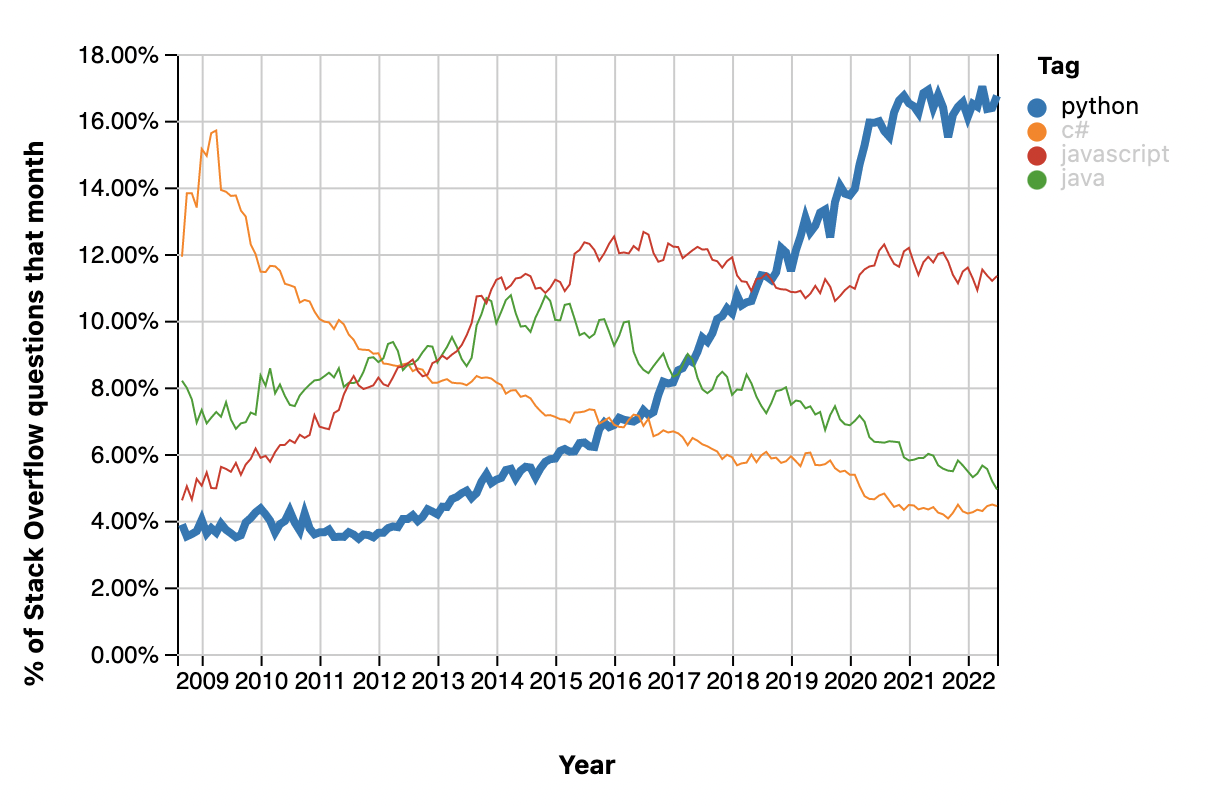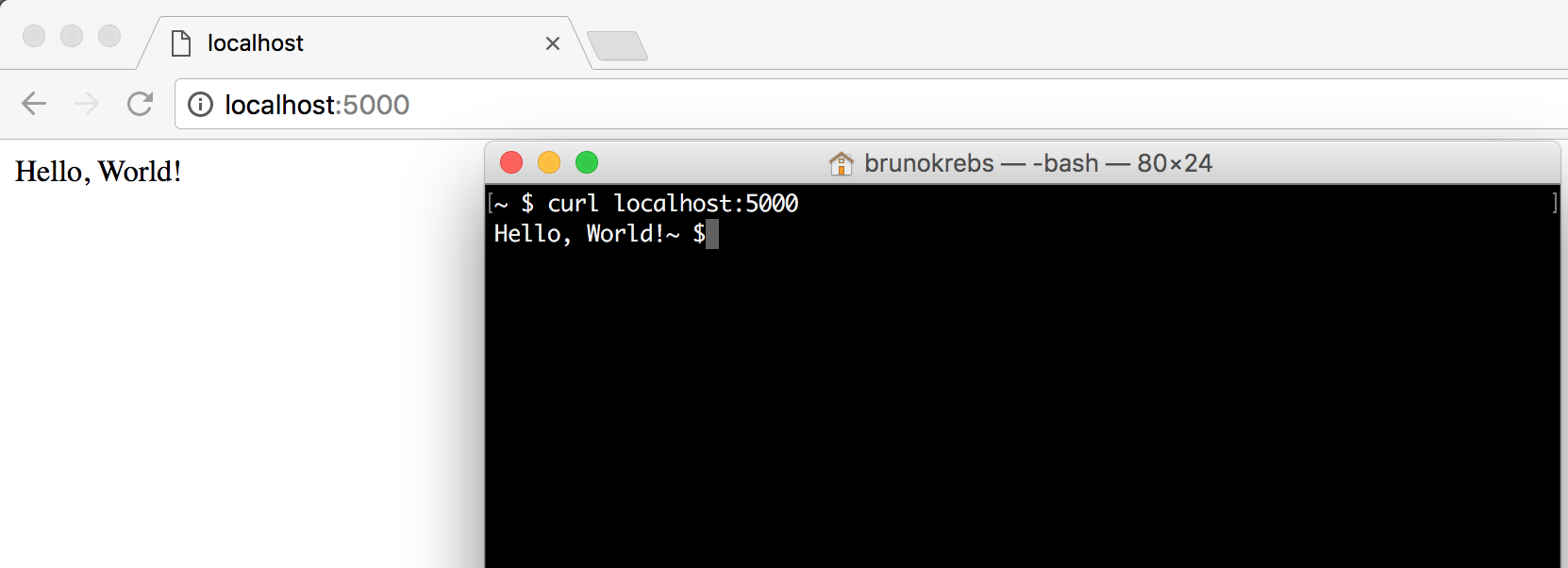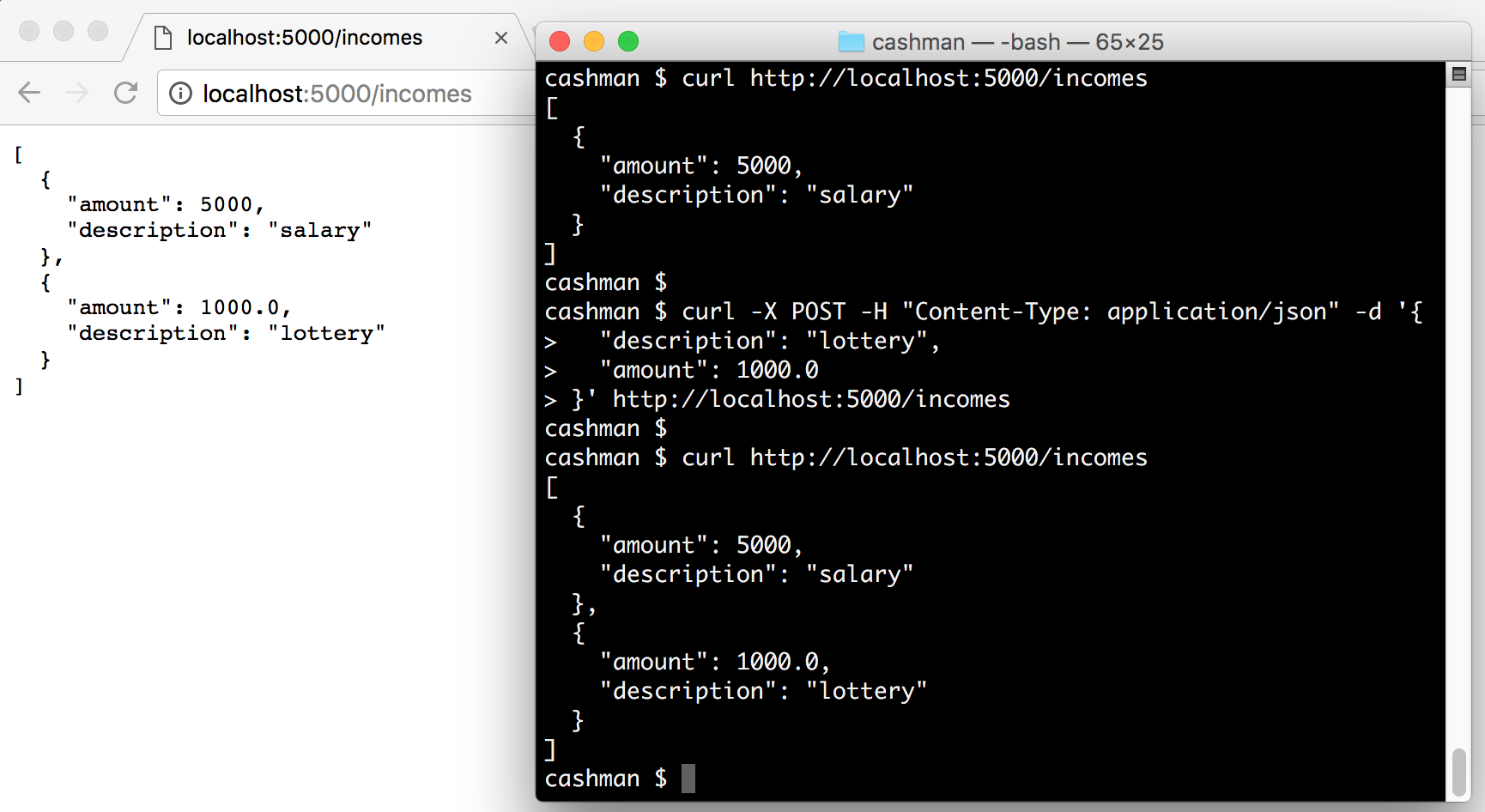TL;DR: Throughout this article, we will use Flask and Python to develop a RESTful API. We will create an endpoint that returns static data (dictionaries). Afterward, we will create a class with two specializations and a few endpoints to insert and retrieve instances of these classes. Finally, we will look at how to run the API on a Docker container. The final code developed throughout this article is available in this GitHub repository. I hope you enjoy it!
“Flask allows Python developers to create lightweight RESTful APIs.”
Tweet This
Summary
This article is divided into the following sections:
- Why Python?
- Why Flask?
- Bootstrapping a Flask Application
- Creating a RESTful Endpoint with Flask
- Mapping Models with Python Classes
- Serializing and Deserializing Objects with Marshmallow
- Dockerizing Flask Applications
- Securing Python APIs with Auth0
- Next Steps
Why Python?
Nowadays, choosing Python to develop applications is becoming a very popular choice. As StackOverflow recently analyzed, Python is one of the fastest-growing programming languages, having surpassed even Java in the number of questions asked on the platform. On GitHub, the language also shows signs of mass adoption, occupying the second position among the top programming languages in 2021.

The huge community forming around Python is improving every aspect of the language. More and more open source libraries are being released to address many different subjects, like Artificial Intelligence, Machine Learning, and web development. Besides the tremendous support provided by the overall community, the Python Software Foundation also provides excellent documentation, where new adopters can learn its essence fast.
Why Flask?
When it comes to web development on Python, there are three predominant frameworks: Django, Flask, and a relatively new player FastAPI. Django is older, more mature, and a little bit more popular. On GitHub, this framework has around 66k stars, 2.2k contributors, ~350 releases, and more than 25k forks.
FastAPI is growing at high speed, with 48k stars on Github, 370 contributors, and more than 3.9k forks. This elegant framework built for high-performance and fast-to-code APIs is not one to miss.
Flask, although less popular, is not far behind. On GitHub, Flask has almost 60k stars, ~650 contributors, ~23 releases, and nearly 15k forks.
Even though Django is older and has a slightly more extensive community, Flask has its strengths. From the ground up, Flask was built with scalability and simplicity. Flask applications are known for being lightweight, mainly compared to their Django counterparts. Flask developers call it a microframework, where micro (as explained here) means that the goal is to keep the core simple but extensible. Flask won't make many decisions for us, such as what database to use or what template engine to choose. Lastly, Flask has extensive documentation that addresses everything developers need to start. FastAPI follows a similar "micro" approach to Flask, though it provides more tools like automatic Swagger UI and is an excellent choice for APIs. However, as it is a newer framework, many more resources and libraries are compatible with frameworks like Django and Flask but not with FastAPI.
Being lightweight, easy to adopt, well-documented, and popular, Flask is a good option for developing RESTful APIs.
Bootstrapping a Flask Application
First and foremost, we will need to install some dependencies on our development machine. We will need to install Python 3, Pip (Python Package Index), and Flask.
Installing Python 3
If we are using some recent version of a popular Linux distribution (like Ubuntu) or macOS, we might already have Python 3 installed on our computer. If we are running Windows, we will probably need to install Python 3, as this operating system does not ship with any version.
After installing Python 3 on our machine, we can check that we have everything set up as expected by running the following command:
python --version # Python 3.8.9
Note that the command above might produce a different output when we have a different Python version. What is important is that you are running at least
Python 3.7python3 --versionpython3pythonInstalling Pip
Pip is the recommended tool for installing Python packages. While the official installation page states that
pip2.7.93.4aptpippip# we might need to change pip by pip3 pip --version # pip 9.0.1 ... (python 3.X)
If the command above produces an output similar to
pip 9.0.1 ... (python 3.X)pip 9.0.1 ... (python 2.X)pippip3Installing Flask
We already know what Flask is and its capabilities. Therefore, let's focus on installing it on our machine and testing to see if we can get a basic Flask application running. The first step is to use
pip# we might need to replace pip with pip3 pip install Flask
After installing the package, we will create a file called
hello.py# hello.py from flask import Flask app = Flask(__name__) @app.route("/") def hello_world(): return "Hello, World!"
These 5 lines of code are everything we need to handle HTTP requests and return a "Hello, World!" message. To run it, we execute the following command:
flask --app hello run * Serving Flask app 'hello' * Debug mode: off WARNING: This is a development server. Do not use it in a production deployment. Use a production WSGI server instead. * Running on http://127.0.0.1:5000 Press CTRL+C to quit
On Ubuntu, we might need to edit the
variable to be able to run flask directly. To do that, let's$PATHand thentouch ~/.bash_aliases.echo "export PATH=$PATH:~/.local/bin" >> ~/.bash_aliases
After executing these commands, we can reach our application by opening a browser and navigating to
http://127.0.0.1:5000/curl http://127.0.0.1:5000/Virtual environments (virtualenv)
Although PyPA—the Python Packaging Authority group—recommends
pippiprequirements.txt
installs packages globally, making it hard to manage multiple versions of the same package on the same machine.pip
need all dependencies and sub-dependencies listed explicitly, a manual process that is tedious and error-prone.requirements.txt
To solve these issues, we are going to use Pipenv. Pipenv is a dependency manager that isolates projects in private environments, allowing packages to be installed per project. If you're familiar with NPM or Ruby's bundler, it's similar in spirit to those tools.
pip install pipenv
Now, to start creating a serious Flask application, let's create a new directory that will hold our source code. In this article, we will create Cashman, a small RESTful API that allows users to manage incomes and expenses. Therefore, we will create a directory called
cashman-flask-projectpipenv# create our project directory and move to it mkdir cashman-flask-project && cd cashman-flask-project # use pipenv to create a Python 3 (--three) virtualenv for our project pipenv --three # install flask a dependency on our project pipenv install flask
The second command creates our virtual environment, where all our dependencies get installed, and the third will add Flask as our first dependency. If we check our project's directory, we will see two new files:
contains details about our project, such as the Python version and the packages needed.Pipfile
contains precisely what version of each package our project depends on and its transitive dependencies.Pipenv.lock
Python packages
Like other mainstream programming languages, Python also has the concept of packages to enable developers to organize source code according to subjects/functionalities. Similar to Java packages and C# namespaces, packages in Python are files organized in directories that other Python scripts can import. To create a package in a Python application, we need to create a folder and add an empty file called
__init__.pyLet's create our first package in our application, the main package, with all our RESTful endpoints. Inside the application's directory, let's create another one with the same name,
cashmancashman-flask-project# create source code's root mkdir cashman && cd cashman # create an empty __init__.py file touch __init__.py
Inside the main package, let's create a script called
index.pyfrom flask import Flask app = Flask(__name__) @app.route("/") def hello_world(): return "Hello, World!"
As in the previous example, our application returns a "Hello, world!" message. We will start improving it in a second, but first, let's create an executable file called
bootstrap.sh# move to the root directory cd .. # create the file touch bootstrap.sh # make it executable chmod +x bootstrap.sh
The goal of this file is to facilitate the start-up of our application. Its source code will be the following:
#!/bin/sh export FLASK_APP=./cashman/index.py pipenv run flask --debug run -h 0.0.0.0
The first command defines the main script to be executed by Flask. The second command runs our Flask application in the context of the virtual environment listening to all interfaces on the computer (
-h 0.0.0.0Note: we are setting flask to run in debug mode to enhance our development experience and activate the hot reload feature, so we don't have to restart the server each time we change the code. If you run Flask in production, we recommend updating these settings for production.
To check that this script is working correctly, we run
./bootstrap.sh* Serving Flask app './cashman/index.py' * Debug mode: on WARNING: This is a development server. Do not use it in a production deployment. Use a production WSGI server instead. * Running on all addresses (0.0.0.0) * Running on http://127.0.0.1:5000 * Running on http://192.168.1.207:5000 Press CTRL+C to quit
Creating a RESTful Endpoint with Flask
Now that our application is structured, we can start coding some relevant endpoints. As mentioned before, the goal of our application is to help users to manage incomes and expenses. We will begin by defining two endpoints to handle incomes. Let's replace the contents of the
./cashman/index.pyfrom flask import Flask, jsonify, request app = Flask(__name__) incomes = [ { 'description': 'salary', 'amount': 5000 } ] @app.route('/incomes') def get_incomes(): return jsonify(incomes) @app.route('/incomes', methods=['POST']) def add_income(): incomes.append(request.get_json()) return '', 204
Since improving our application, we have removed the endpoint that returned "Hello, world!" to users. In its place, we defined an endpoint to handle HTTP
GETPOST@app.route/incomesTo facilitate the process, we currently manipulate incomes as dictionaries. However, we will soon create classes to represent incomes and expenses.
To interact with both endpoints that we have created, we can start our application and issue some HTTP requests:
# start the cashman application ./bootstrap.sh & # get incomes curl http://localhost:5000/incomes # add new income curl -X POST -H "Content-Type: application/json" -d '{ "description": "lottery", "amount": 1000.0 }' http://localhost:5000/incomes # check if lottery was added curl localhost:5000/incomes
Mapping Models with Python Classes
Using dictionaries in a simple use case like the one above is enough. However, for more complex applications that deal with different entities and have multiple business rules and validations, we might need to encapsulate our data into Python classes.
We will refactor our application to learn the process of mapping entities (like incomes) as classes. The first thing that we will do is create a subpackage to hold all our entities. Let's create a
modelcashman__init__.py# create model directory inside the cashman package mkdir -p cashman/model # initialize it as a package touch cashman/model/__init__.py
Mapping a Python Superclass
We will create three classes in this new directory:
TransactionIncomeExpenseTransactiontransaction.pymodelimport datetime as dt from marshmallow import Schema, fields class Transaction(object): def __init__(self, description, amount, type): self.description = description self.amount = amount self.created_at = dt.datetime.now() self.type = type def __repr__(self): return '<Transaction(name={self.description!r})>'.format(self=self) class TransactionSchema(Schema): description = fields.Str() amount = fields.Number() created_at = fields.Date() type = fields.Str()
Besides the
TransactionTransactionSchemaTransactionSchema# installing marshmallow as a project dependency pipenv install marshmallow
Marshmallow is a popular Python package for converting complex datatypes, such as objects, to and from built-in Python datatypes. We can use this package to validate, serialize, and deserialize data. We won't dive into validation in this article, as it will be the subject of another one. Though, as mentioned, we will use
marshmallowMapping Income and Expense as Python Classes
To keep things more organized and meaningful, we won't expose the
TransactionIncomeExpenseincome.pymodelfrom marshmallow import post_load from .transaction import Transaction, TransactionSchema from .transaction_type import TransactionType class Income(Transaction): def __init__(self, description, amount): super(Income, self).__init__(description, amount, TransactionType.INCOME) def __repr__(self): return '<Income(name={self.description!r})>'.format(self=self) class IncomeSchema(TransactionSchema): @post_load def make_income(self, data, **kwargs): return Income(**data)
The only value that this class adds for our application is that it hardcodes the type of transaction. This type is a Python enumerator, which we still have to create, that will help us filter transactions in the future. Let's create another file, called
transaction_type.pymodelfrom enum import Enum class TransactionType(Enum): INCOME = "INCOME" EXPENSE = "EXPENSE"
The code of the enumerator is quite simple. It just defines a class called
TransactionTypeEnumINCOMEEXPENSELastly, let's create the class that represents expenses. To do that, let's add a new file called
expense.pymodelfrom marshmallow import post_load from .transaction import Transaction, TransactionSchema from .transaction_type import TransactionType class Expense(Transaction): def __init__(self, description, amount): super(Expense, self).__init__(description, -abs(amount), TransactionType.EXPENSE) def __repr__(self): return '<Expense(name={self.description!r})>'.format(self=self) class ExpenseSchema(TransactionSchema): @post_load def make_expense(self, data, **kwargs): return Expense(**data)
Similar to
IncomeEXPENSEamountSerializing and Deserializing Objects with Marshmallow
With the
Transaction./cashman/index.pyfrom flask import Flask, jsonify, request from cashman.model.expense import Expense, ExpenseSchema from cashman.model.income import Income, IncomeSchema from cashman.model.transaction_type import TransactionType app = Flask(__name__) transactions = [ Income('Salary', 5000), Income('Dividends', 200), Expense('pizza', 50), Expense('Rock Concert', 100) ] @app.route('/incomes') def get_incomes(): schema = IncomeSchema(many=True) incomes = schema.dump( filter(lambda t: t.type == TransactionType.INCOME, transactions) ) return jsonify(incomes) @app.route('/incomes', methods=['POST']) def add_income(): income = IncomeSchema().load(request.get_json()) transactions.append(income) return "", 204 @app.route('/expenses') def get_expenses(): schema = ExpenseSchema(many=True) expenses = schema.dump( filter(lambda t: t.type == TransactionType.EXPENSE, transactions) ) return jsonify(expenses) @app.route('/expenses', methods=['POST']) def add_expense(): expense = ExpenseSchema().load(request.get_json()) transactions.append(expense) return "", 204 if __name__ == "__main__": app.run()
The new version that we just implemented starts by redefining the
incomesExpensesIncomestransactionsIncomeSchemafiltertransactionsThe endpoint responsible for accepting new incomes was also refactored. The change on this endpoint was the addition of
IncomeSchemaIncometransactionsTransactionIncomeThe other two endpoints responsible for dealing with expenses,
get_expensesadd_expenseincome- instead of dealing with instances of
, we deal with instances ofIncome
to accept new expenses,Expense - and instead of filtering by
, we filter byTransactionType.INCOME
to send expenses back to the user.TransactionType.EXPENSE
This finishes the implementation of our API. If we run our Flask application now, we will be able to interact with the endpoints, as shown here:
# start the application ./bootstrap.sh # get expenses curl http://localhost:5000/expenses # add a new expense curl -X POST -H "Content-Type: application/json" -d '{ "amount": 20, "description": "lottery ticket" }' http://localhost:5000/expenses # get incomes curl http://localhost:5000/incomes # add a new income curl -X POST -H "Content-Type: application/json" -d '{ "amount": 300.0, "description": "loan payment" }' http://localhost:5000/incomes
Dockerizing Flask Applications
As we are planning to eventually release our API in the cloud, we are going to create a
DockerfileDockerfileLet's create the
Dockerfile# Using lightweight alpine image FROM python:3.8-alpine # Installing packages RUN apk update RUN pip install --no-cache-dir pipenv # Defining working directory and adding source code WORKDIR /usr/src/app COPY Pipfile Pipfile.lock bootstrap.sh ./ COPY cashman ./cashman # Install API dependencies RUN pipenv install --system --deploy # Start app EXPOSE 5000 ENTRYPOINT ["/usr/src/app/bootstrap.sh"]
The first item in the recipe defines that we will create our Docker container based on the default Python 3 Docker image. After that, we update APK and install
pipenvpipenvpipenv5000bootstrap.shNote: For our
, we use Python version 3.8, however, depending on your system configuration,Dockerfilemay have set a different version for Python in the filepipenv. Please make sure that the Python version in bothPipfileandDockerfileare aligned, or the docker container won't be able to start the server.Pipfile
To create and run a Docker container based on the
Dockerfile# build the image docker build -t cashman . # run a new docker container named cashman docker run --name cashman \ -d -p 5000:5000 \ cashman # fetch incomes from the dockerized instance curl http://localhost:5000/incomes/
The
DockerfileDockerfileSecuring Python APIs with Auth0
Securing Python APIs with Auth0 is very easy and brings a lot of great features to the table. With Auth0, we only have to write a few lines of code to get:
- A solid identity management solution, including single sign-on
- User management
- Support for social identity providers (like Facebook, GitHub, Twitter, etc.)
- Enterprise identity providers (Active Directory, LDAP, SAML, etc.)
- Our own database of users
For example, to secure Python APIs written with Flask, we can simply create a
requires_auth# Format error response and append status code def get_token_auth_header(): """Obtains the access token from the Authorization Header """ auth = request.headers.get("Authorization", None) if not auth: raise AuthError({"code": "authorization_header_missing", "description": "Authorization header is expected"}, 401) parts = auth.split() if parts[0].lower() != "bearer": raise AuthError({"code": "invalid_header", "description": "Authorization header must start with" " Bearer"}, 401) elif len(parts) == 1: raise AuthError({"code": "invalid_header", "description": "Token not found"}, 401) elif len(parts) > 2: raise AuthError({"code": "invalid_header", "description": "Authorization header must be" " Bearer token"}, 401) token = parts[1] return token def requires_auth(f): """Determines if the access token is valid """ @wraps(f) def decorated(*args, **kwargs): token = get_token_auth_header() jsonurl = urlopen("https://"+AUTH0_DOMAIN+"/.well-known/jwks.json") jwks = json.loads(jsonurl.read()) unverified_header = jwt.get_unverified_header(token) rsa_key = {} for key in jwks["keys"]: if key["kid"] == unverified_header["kid"]: rsa_key = { "kty": key["kty"], "kid": key["kid"], "use": key["use"], "n": key["n"], "e": key["e"] } if rsa_key: try: payload = jwt.decode( token, rsa_key, algorithms=ALGORITHMS, audience=API_AUDIENCE, issuer="https://"+AUTH0_DOMAIN+"/" ) except jwt.ExpiredSignatureError: raise AuthError({"code": "token_expired", "description": "token is expired"}, 401) except jwt.JWTClaimsError: raise AuthError({"code": "invalid_claims", "description": "incorrect claims," "please check the audience and issuer"}, 401) except Exception: raise AuthError({"code": "invalid_header", "description": "Unable to parse authentication" " token."}, 400) _app_ctx_stack.top.current_user = payload return f(*args, **kwargs) raise AuthError({"code": "invalid_header", "description": "Unable to find appropriate key"}, 400) return decorated
Then use it in our endpoints:
# Controllers API # This doesn't need authentication @app.route("/ping") @cross_origin(headers=['Content-Type', 'Authorization']) def ping(): return "All good. You don't need to be authenticated to call this" # This does need authentication @app.route("/secured/ping") @cross_origin(headers=['Content-Type', 'Authorization']) @requires_auth def secured_ping(): return "All good. You only get this message if you're authenticated"
To learn more about securing Python APIs with Auth0, take a look at this tutorial. Alongside with tutorials for backend technologies (like Python, Java, and PHP), the Auth0 Docs webpage also provides tutorials for Mobile/Native apps and Single-Page applications.
Next Steps
In this article, we learned about the basic components needed to develop a well-structured Flask application. We looked at how to use
pipenvAlthough well structured, our API is not that useful yet. Among the things that we can improve, we are going to cover the following topics in the following article:
- Database persistence with SQLAlchemy
- Add authorization to a Flask API application
- How to handle JWTs in Python
Stay tuned!




